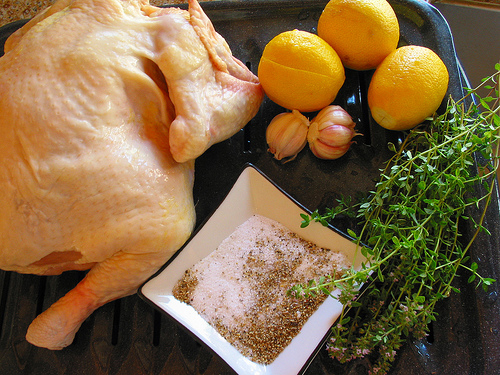 Want it free of drug-resistant salmonella? Make it organic.Photo: sierravalleygirlThis study from the University of Georgia’s Center for Food Safety came out in November and has bounced around the internet, but for some reason I’m just now noticing it. It’s worth a look.
Want it free of drug-resistant salmonella? Make it organic.Photo: sierravalleygirlThis study from the University of Georgia’s Center for Food Safety came out in November and has bounced around the internet, but for some reason I’m just now noticing it. It’s worth a look.
The researchers looked at broilers — chickens raised for meat — from “three organic and four conventional broiler farms from the same company in North Carolina,” and tested their manure for salmonella. They also tested samples of their feed.
Here’s what they found: 38.8 percent of the conventional birds were carrying salmonella, versus 5.6 percent for the organic birds. As for feed, 27.5 percent of the conventional feed samples were carrying the pathogen, versus 5 percent of the organic. Recall that in the vast salmonella-egg recall of last year, authorities homed in on tainted feed as the likely source of contamination.
Now for the creepy part: 39.7 percent of the salmonella found in the conventional birds had resistance to no fewer than six different antibiotics. None of the salmonella from the organic birds showed antibiotic resistance.
So, what’s the context of the study — what are the differences in conditions for organic and conventional broiler birds? The birds under examination all came from the same company. Both kinds are raised in what the researchers call “houses.” It’s probably safe to assume that the organic ones are grown in conditions that Michael Pollan calls “industrial organic” — an attempt to mimic not the way birds live in the wild, but rather the regimented processes of industrial production, while following the letter of organic code.
According to a lucid explanation of USDA organic poultry standards [PDF] from the National Sustainable Agriculture Information Service (ATTRA), organic birds have to get “access to the outdoors for exercise areas, fresh air and sunlight.” But in Omnivore’s Dilemma, Pollan demonstrated that that rule is often implemented as a farce — birds have access to a door to the outdoors, but never utilize it out of fear — they’ve never been outdoors before. Nor are there any stipulations on how densely the birds can be housed, ATTRA reports.
Crucially, though, organic code forbids antibiotics and other “animal drugs.” And without loads of antibiotics and other antimicrobial drugs, you probably can’t stuff as many birds in an organically managed house as you do in a conventionally grown one. “Most [organic producers] look for at least 1.5 square feet (0.14 square meters) per bird,” ATTRA states. In conventional chicken houses where the feed is laced with antibiotics, conditions are quite different, according to this Humane Society of the United States document [PDF]:
Under standard commercial conditions chickens weighing 4.5 to 6 lbs have little more than a half a square foot of living space per bird in the last two weeks of their 42-47 days of life.
Then there’s the question of feed. In addition to the ban on antimicrobials, organic code also forbids “animal slaughter byproducts” in feed, ATTRA states. Conventional feed mixers labor under no such constraints.
As the menace of antibiotic resistance from factory farms grows — now acknowledged by the FDA, the USDA, and the CDC, although no regulatory response has yet been mounted to it — the University of Georgia study results are interesting, indeed. Clearly the subject merits — no, demands — more research.



